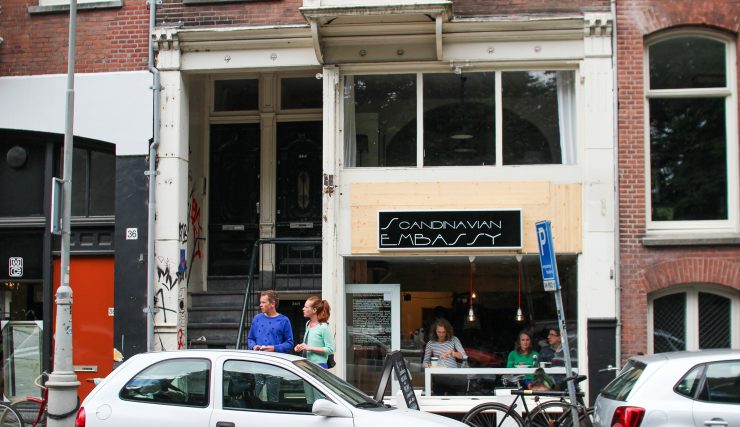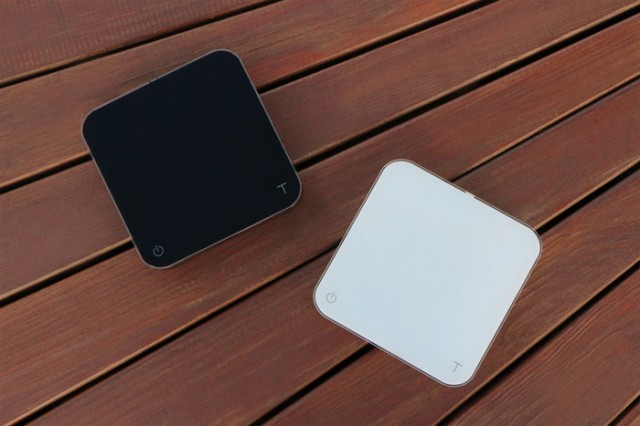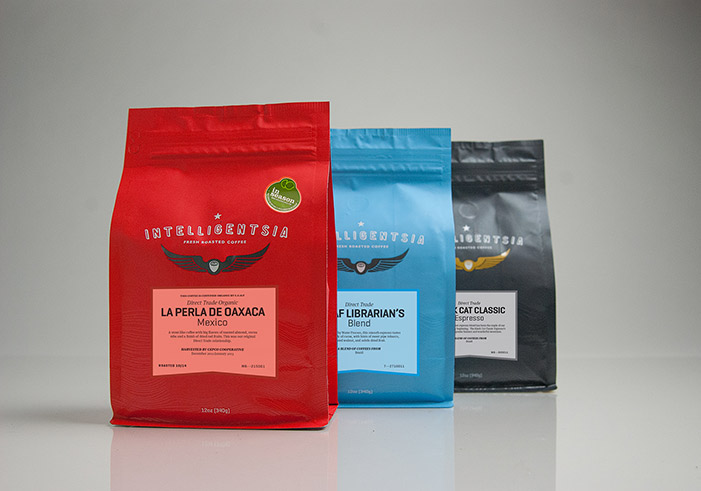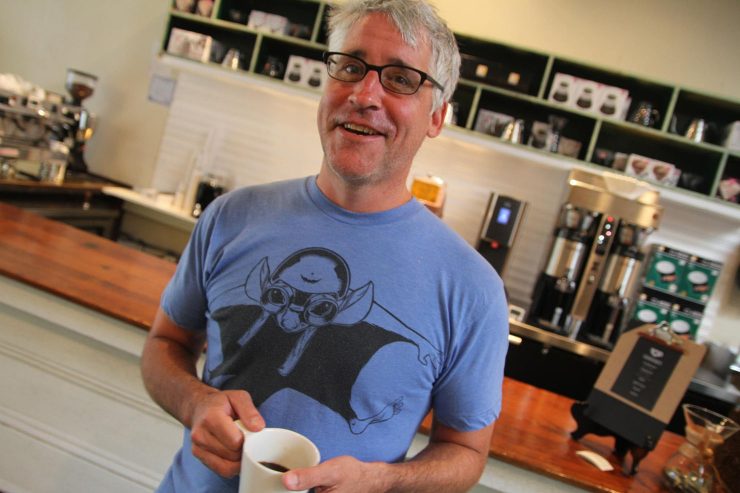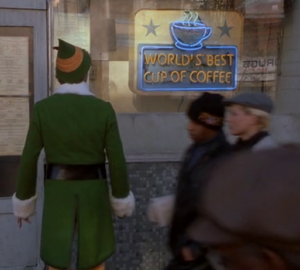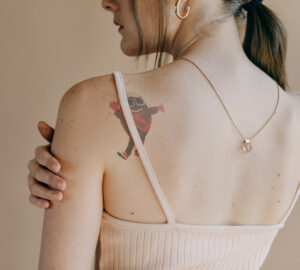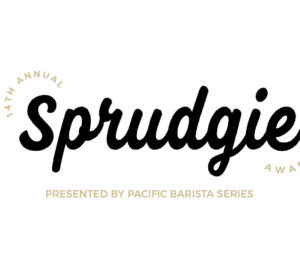Welcome to the 6th annual Sprudgie Awards! The Sprudgies honor notable achievements in coffee in a variety of categories, awarded each year after careful deliberation. This year’s awards were authored by Sprudge.com’s editorial team of Liz Clayton, Alex Bernson, Jordan Michelman and Zachary Carlsen.
Best New Cafe: Scandinavian Embassy
Notable Roaster: Small Batch Roasting Company
Best Coffee Writing: Alexis Madrigal, The Atlantic
Notable Producer: Cuatro M/Emilio Lopez Diaz
Best Coffee Video: Dunkin Love
Best New Product: Acaia Coffee Scale
Best Subscription: Ruby Coffee
Best Packaging: Intelligentsia
Outstanding Achievement In The Field Of Excellence: Jim Karr
Best New Cafe: Scandinavian Embassy
In a year chock full of new openings, 2014 showed us massive concept cafes from Seattle to Philadelphia, international multiroasters in London and Singapore, design palaces in Tampa, cool trucks gone brick and mortar in Montreal, experimental restaurant coffee programs, all manner of converted warehouses (from Poland to Pennsylvania), and much more. In this year of turbulent and exciting openings of all sorts of different concept mishmashes, it was very hard to pick a favorite, or certainly best, cafe–there are so many options and variations catering to so many different cafe desires that in the end it felt like more a question of personal preference.
So then, our personal choice for the Best New Cafe Sprudgie Award goes to a little spot in Amsterdam. an emerging coffee city run by a couple of guys who have been best friends since high school. At Scandinavian Embassy, Chef Rikard Andersson and barista Nicolas Castagno have taken a little shotgun apartment on a sleepy parkside block in De Pijp and turned it into a new international destination for fusing together coffee and food. Yes, we’re aware that Scandinavian Embassy technically opened in late 2013, but ’14 was when they came into their own and established something truly special. We like the place enough to overlook a little chronological quibble, and really, in a year of so many high-profile but still largely unproven concepts, Scandinavian Embassy’s ability to survive, refine and grow over the course of a year is particularly noteworthy.
Castagno’s coffee is Nordic, highlighting the very best roasters in the region like Drop Coffee (Sweden), Tim Wendelboe (Norway), and The Coffee Collective (Denmark). Andersson’s food is a gleeful amalgam of Dutch dairy and produce, rural Swedish farm traditions, and fine dining training. Presented in concert, Mr. Andersson’s food and Mr. Castagno’s coffee are allowed to riff and play together in an intimate bar setting. We still think it is one of the best coffee & breakfast experiences currently available to humans on this planet.
Coffee and food wasn’t just a hot topic in 2014; it’s emerging as the biggest trend of this decade, evidenced by coffee’s gleeful integration into events like MAD Food and a growing international Melbournian brekkie fetishism. Big time food with high-end coffee isn’t going away–indeed, it will only become more prevalant, and perhaps dilute, as time goes on. There will be loving tributes and opportunistic hop-ons and everything in-between.
At Scandinavian Embassy, they’re putting food and coffee together with heart, soul and wit. It was our favorite new cafe of 2014. Go here.
— Jordan Michelman
Notable Roaster: Small Batch Roasting Company
At this point it’s no longer an argument: Melbourne’s coffee culture is leading the world. But who’s the most important roaster in the city? What is Melbourne’s top cafe district? Its best cafe? These questions are far from settled in the world’s most exciting and densely saturated specialty coffee city. Standing out here is tough, but for our 2014 Notable Roaster award, we’re looking to reflect back the choices that have already been made by the city’s most discerning cafe owners and baristas. Because while Melbourne may have hundreds of cafes presenting themselves as “specialty,” not all of those cafes are special. And among the ones that are, there’s a common thread: Small Batch Roasting Company.
You can find Small Batch at Melbourne’s very finest cafes, including shops like Assembly, Everyday Coffee, and Patricia Coffee Brewers. Outside Melbourne there are notables like Standing Room Only and Addison & Steele in Perth, Paramount Coffee Project in Sydney, and The New Black in Singapore. Cultishly revered, with every change and uptick tracked by the faithful, the popular obsession with Small Batch’s Candyman espresso blend among Melbourne coffee dorks reminds us of the cargo cults of Black Cat and Hair Bender back in the United States.
You can also find Small Batch’s coffee menu served at its genre-defining flagship restaurant/coffee bar hybrid, Auction Rooms. When Americans think of Melbourne coffee, this is what they’re dreaming of: a full-service restaurant literally owned by the roaster, with coffees carefully prepared by top baristas and given full appreciation in the form of an ever-changing daily menu of offerings alongside delicious, innovative breakfast and lunch foods.
2014 was a year of precipitous growth for Small Batch. Some highlights:
Early on in 2014, Small Batch rolled out approachable, minimalist new packaging. They also opened The Counter, a takeaway bar with excellent coffee to supplement the crowds still thronging to Auction Rooms during morning and lunch rush times.
A few months later the brand debuted an ambitious big city cafe project produced in partnership with Broadsheet, a popular Australian food culture publication, and the Bank of Melbourne, an enormous financial institution. Called Filter, this cafe was anything but safe—our first look called it “avant-garde”, and months later we remain impressed by the chance-taking and conceptual chutzpah of the space. Risky, bold, innovative—Filter is the opposite of what most coffee companyies would do under the same kind of scrutiny, and all the more remarkable for it.
To close the year, Small Batch’s core team of owner Andrew Kelly and chief lieutenant Aaron Wood grew to include Tim Varney, an Australian best known for his work alongside Tim Wendelboe in Oslo (and for inventing the World AeroPress Championships). It was, in its own Melbournian humble sort of way, a power move for Small Batch, snapping up arguably the biggest free agent in Australian coffee and growing their knowledge and resource base in the process.
Hotly competitive, spoiled for choice—standing out in Melbourne’s coffee scene is no small feat. Small Batch has grown in leaps and strides in 2014, while maintaining the coffee quality that attracted locals in the first place. In Melbourne, you vote with your dollar, and many of the city’s top cafes have cast their vote loud and clear for Small Batch. We’re merely echoing the “aye”.
— Jordan Michelman

Best Coffee Writing: Alexis Madrigal, The Atlantic
2014 saw coffee-related stories showing up across all manner of publications in a matter-of-course sort of way that would have been all but unthinkable just two years ago. Coffee is beginning to become just another beat, and on that beat, Blue Bottle Coffee’s various maneuverings emerged as the most intensely trumpeted, picked apart, puzzled over, chided, and reblogged topic of the year. Alexis Madrigal’s piece on Blue Bottle’s iced coffee plans in The Atlantic stands out from this media dogpile as an intricate, well-researched piece that takes the time to deeply understand the passions behind its subject before expressing, clarifying, and perhaps evangelizing it in a way that is accessible to a broad audience.
In many ways, this 5.6k word essay retreads clichés of mainstream writing about coffee in the last five years: knowing winks at Portlandia-ification; treating coffee people talking very intricately about flavor as noteworthy; recounting the creative-professional rags-to-riches story of Blue Bottle’s artisan farmers market roots. Madrigal even includes the requisite ‘it all makes sense, he’s an artist’ mention of Blue Bottle founder James Freeman’s history as a clarinet player, echoing the requirement that all early 2000s pieces on Espresso Vivace’s David Schomer include the tidbit that he began as a professional flautist.
In other writers’ hands, the clichés of the coffee narrative often feel tired or tone-deaf, but Madrigal is able to use them to construct a canonical example of the form, an exploration of modern branding, authenticity and production that places these glimpsed insights in the proper context, demonstrating their genuine explicative power, and in the process belying a deeper insight into the subject than the author may have first let on.
The essay begins with an appeal to the everyman interest of iced coffee, told through an emotional first person lens that attempts to authorize in the reader an interest in the finer points of coffee—an interest that many still see as unseemly, something overly precious. As Madrigal introduces Freeman in all his quirks and recounts the iced coffee’s careful development story, Madrigal slowly code-switches more and more into the same “intricate, unembarrassed” descriptions of coffee and brewing process that he first marveled at from Freeman. By the end of the piece, one gets the distinct sense that Madrigal has been something of a coffee geek all along, or at least caught the bug hard in the course of researching his piece, and that his meticulous unfolding of the world of quality (iced) coffee is not just a journalistic exploration, but something of a personal apologia.
The resulting essay is a deeply researched and referenced piece of mainstream journalism written by someone who is actually familiar with modern coffee. Madrigal tells a convincing personal story about how the very real phenomenon of delicious coffee being, well, delicious, has played a role in his life, and in taking the quality coffee movement seriously, he is able to see that the challenges facing coffee craftspeople are the same challenges facing so many professional crafts in this day and age. For the moment, this essay feels like a wonderful novelty, but it’s also hopefully a sign of things to come as mainstream readers and writers more fully embrace a deep passion for coffee.
And if that isn’t enough to convince you, Madrigal also made a cheesy “varietal” joke and didn’t use the word “hipster” once in 5.6k words of coffee writing. Truly, a piece after Sprudge’s own heart.
— Alex Bernson
Notable Producer: Cuatro M/Emilio Lopez Diaz
If you watched any barista competition in 2014, chances are you heard the names Cuatro M and Emilio Lopez Diaz. 2014 US Barista Champion Laila Ghambari and 2014 Australian Barista Champion Craig Simon both used coffees produced by Lopez at his Finca El Manzano in El Salvador. Cuatro M is not merely notable for its fantastic coffees though—the company has also seen great success with combatting coffee leaf rust, or roya, to ensure production, and creating a recognizable international brand for themselves.
Much of this visibility comes from Mr. Lopez’s tireless work promoting Cuatro M and El Salvadoran coffees on the global stage. Ghambari made Cuatro M a big focus in her routine, extolling the custom processing experiments they conducted for her competition coffees, working in close partnership with roaster Phil Beattie at Dillanos. When it came time for Ghambari to compete at USBC, Lopez flew up to cheer her on, and he was in the stands cheering on his competitors at the WBC as well. Lopez, who went to college in Portland, Oregon, understands not just the importance of partnering across the supply chain, but also of marketing yourself on your own terms: Cuatro M boasts an engaging web and social media presence, and Lopez is a regular figure at events like Sustainable Harvest’s Let’s Talk Coffee.
We had the chance to visit Finca El Manzano during the 2013 LTC event, and it was an eye-opening experience. The Cuatro M team doesn’t stand on tradition, and their farms are fascinating labs exploring all sorts of unorthodox approaches. In the picture above, you can see them growing high quality arabica coffee in neatly organized, mostly shade-free rows, which Lopez says does wonders for production and decreasing roya susceptibility in their microclimate. Manzano faced many challenges from roya, but with aggressive pruning, targeted spraying, and replanting of trees, they’ve shown that its possible to persevere and continue to make world-class coffees.
— Alex Bernson
Best Coffee Video: Dunkin Love
While 2014 saw a number of beautiful, exotic, and international feature-length coffee films, we’re giving the honor to an understated video shot on the beaches of the San Francisco Bay area. Artists Adrian Anchondo and Reggie D. White shot a parody of Beyoncé’s “Drunk In Love” music video in January 2014, masterfully replicating each shot, turning Yoncé’s ballad into a love letter to Dunkin Donuts. The song, “Dunkin Love”, celebrates the East Coast chain while longing for its expansion west. The perfect pop-culture coffee mashup.
The video, which is 1nearing one million views on YouTube, might have helped push the execs at Dunkin to finally expand to California. 2014 brought three Los Angeles locations, and it’s been reported that Dunkin aims to open 26 San Francisco locations in 2016.
In a post on its own blog, Dunkin’ Donuts says, “Hey San Fran, we heard you love Dunkin’.” Sly nod to White and Anchondo’s video? Obviously.
— Zachary Carlsen
Best New Product: Acaia Coffee Scale
Giving coffee equipment the power of Bluetooth opens up doors we never dreamed existed, and the Acaia scale is on the forefront of digital kitchen scale / smart phone app integration. Though the readymade app still leaves us wanting more (get on it, Silicon Valley developers) we can’t get over how the Acaia sneakily improved the digital kitchen scale in two important ways:
1. Rechargeable batteries by way of USB.
2. Waterproof outside parts.
For cafes that use scales for espresso making or coffee brewing, replacing batteries and broken water-logged scales has previously been built in to monthly operational budgets, and the Acaia scale has effectively and quietly put an end to that era.
This was clearly *the* coffee product of 2014, and can be found already integrated into the brew bars and coffee services at many of the world’s best cafes. Now we’ll just sit by and wait for the Acaia Mini.
— Zachary Carlsen
Best Packaging: Intelligentsia
Confession time: I am packaging impaired. From cereal boxes to shipping crates to countless unfortunate coffee bags, my life has been spent accidentally destroying the pretty, pretty packaging my favorite things come swaddled in. It’s kind of a shame, actually—I love packaging and branding, but in my hands that beauty is laid waste by fumbling, tearing, and all manner of manhandling.
Which is why I’m obsessed with Intelligentsia’s new update to their iconic packaging. Developed in collaboration with Pacific Bag, the new Intelli bags comes with a simple pull-tab to open and a resealable zipper. They’ve idiot-proofed the bag so that not even I can mess it up. The zipper is clean and easy to use, plus the tactile sensation of yanking that pull tab really can’t be beat. What will they think of next?
I wish all products—coffee, cereal, you name it—came in this packaging. The bags stand up straight. The coffee stays fresh. There is order to the universe.
— Jordan Michelman
Best Subscription: Ruby Coffee
These days there’s a mail-order coffee subscription for every taste and proclivity imaginable. Ever-changing samplers of seasonal artisan roasts are available from a range of third party curators who gleefully repackage beans, right to your door. Single-roaster subscriptions have risen in sophistication, too—the defunct Tonx was bought out by Blue Bottle Coffee largely for its sexy subscription infrastructure. It’s not an easy modern landscape to compete in.
It can be even harder without long-term name recognition. Ruby Coffee, helmed by mom-and-pop duo of Jared and Deanna Linzmeier, set up shop in Jared Linzmeier’s native Central Wisconsin in 2013, with the ex-Intelligentsia and Ladro roaster’s promise to roast “colorful” and delicious coffees in, uh, the woods. But Amherst Junction—and even big-city Stevens Point—aren’t what most of coffee’s culinary snobs might consider progressive (beyond a thriving beer and cheese culture, of course). The task would be trickier than at other coffee startups: while the overhead to set up a roastery and raise a family on Jared Linzmeier’s family land would be low, getting the national exposure—and volume—needed to bankroll their progressive roasting styles and appropriately-priced single origins would be a challenge. Ruby’s risen to it quickly though, through a reputation built on the quality coffees they began producing seemingly right away, and via a healthy dose of well-conceived and copiously deployed aw-shucks-it-snowed-again Midwestern social media charm.
When I was looking for a coffee subscription earlier this year for great beans I couldn’t get readily in New York City, Ruby came immediately to mind. Being able to peek into a window of a new roaster that has the freedom to both experiment and, well, be themselves while creating a brand that’s both local and international is exciting. And the coffees? Well-selected, lovingly roasted, and delicious in the cup. We’re awarding them best subscription because, chances are, you’re too far from Amherst Junction to pick up a fresh-roasted bag yourself. But also because we’ve been nothing but impressed by Ruby’s ability to make a great name for itself in spite—or perhaps because—of its geography.
— Liz Clayton
Outstanding Achievement in the Field of Excellence: Jim Karr
I’ve always been a superfan of the supporting players in life, and coffee is full of them. In my hometown of Chicago, my early explorations of what we call specialty coffee hinged mostly on the huge fish in a then-small pond. The late ’00s Intelligentsia was a culture of medium-time-celebrity baristas, transcontinental expansion, innovation promise and burgeoning excitement. But operating quietly behind the three Chicago cafes (and pedway!), the growing roster of barista champions, the geek-crowded, “it girl” SCAA booths, and crouched below the countertops of mega-hyped cafes in Los Angeles, was a wry-smiled fellow with an arsenal of all the tools—quiet humor included—to make a little behind-the-scenes elbow grease showcase coffee in groundbreaking, meaningful ways that would have lasting effects on our industry.
Jim Karr was a coffee tech. The guy with the plumbing and electrical know-how to install your espresso machine, fix whatever was gushing water all over your cafe floor, and generally make coffee exist in any public environment. He was known to many as quiet, funny, and hardworking, though if you knew him at all you also knew the side that was just as excited for the drinks with friends after the job well done as the job well done itself. Jim was slow to know, but unfolded with a warmth and loyalty that suffused his actions both in and out of work, and his smile was broad and truly genuine. If you saw Jim Karr when you came into a coffee shop, you always knew it was a bad sign, because it probably meant some vessel you’d hoped to buy coffee out of was broken. But the smile he gave you at the meeting of a friend always made you instantly forget any disappointment at realizing the espresso machine was in pieces all over the floor. No espresso? No problem. Drip’s down too? That’s fine. I’ll just have a water and a chat with my pal Jim.
People all over Chicago were charmed by Jim’s soft temperament, as were they nationally upon meeting Jim at conferences or, naturally, good parties. Of course, Jim Karr was not a saint, and anyone who witnessed his inelegant parting of ways from Intelligentsia in 2012 can attest to his rather vocal taking of the lower road. But the energy that fueled his public pot-shots and ill-tempered tweets propelled him: soon after, he’d open SteamVolt, Chicago’s first specialty-coffee-focused independent tech company, and begin thriving in a way—and in a coffee industry—he’d likely never envisioned when he left a career selling beepers to fix coffee machines in the early 1990s.
Jim was killed in an accident in May of 2014, while he was setting up a large Fetco coffee brewer in Chicago’s Grant Park while helping his friends at Dark Matter Coffee prepare a coffee tent for the annual Bike The Drive event, in which beautiful Lake Shore Drive is closed to motorists so that cyclists may enjoy the full expanse along Lake Michigan. That Jim’s life would end just a couple days shy of his 49th birthday is undeniably, horribly, heartbreakingly sad to those of us who knew him. But with time, I’ve taken comfort in knowing that The Silver Fox went out at the top of his game. He’d started a successful company; he was his own boss; he had been able to work with, and provide work to his trusted friends; he had found a beautiful, enduring love with his partner Esther; and he died doing what he loved on a sunny spring day.
To lose someone well-known in an industry is one thing, but to recognize the people who receive a bit less amplification is a reminder of how much we rely on the entire structure of coffee to get that drink into a cup. From the under-recognized women from producing households whose names do not make it onto the pretty coffee bags to the guy replacing your gaskets after hours, coffee creates a community with many important parts. Jim Karr was an example of one of those important parts. Jim was a great coffee person who died in the line of duty, and his contributions and successes, perhaps even his little failures, are representative of the growth of our industry. We at Sprudge recognize his life’s work as meaningful both personally and professionally, and are honored to be able to shed a little more light on Jim and people like him through this award.
— Liz Clayton












